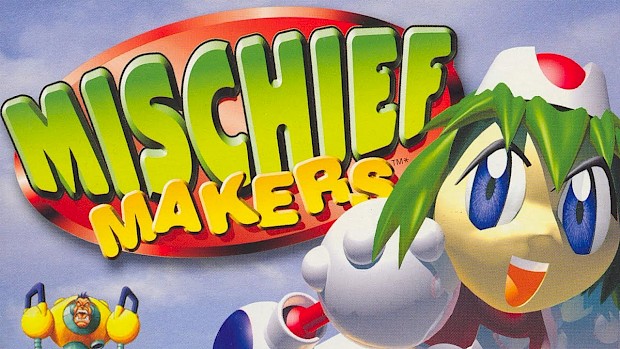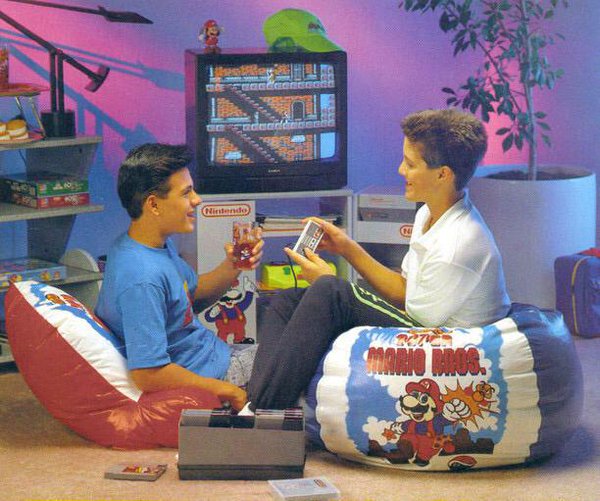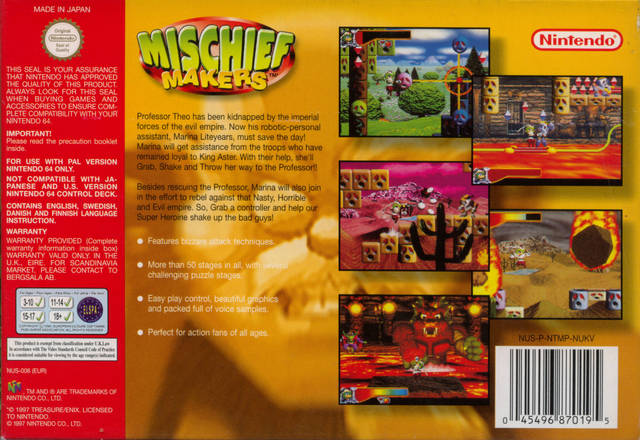Throwback Thursday #19 - Mischief Makers

Posted 14 Apr 2016 at 17:28 by Joshua Phillips
In a time when 3D platformers were all the rage, this bizarre and overtly Japanese game went against the grain with it's 2.5D style and unique game mechanics. Read on to find out why Ashley loved it so much...

 Shake, shake!
Shake, shake!
Mischief Makers is one of those weird titles (in many senses of the word) where I can’t recall why I ended up with it. I recall as a child my mother would occasionally buy us games for no reason at all (i.e. it wasn’t Christmas) and obviously I was delighted, but could never figure out why it was always a specific game. I recall Toy Story 2 being another game like this. As an adult I realised it was because the game was on offer, but as a child I was perplexed but went with it.
Maybe that’s why Mischief Makers ended up in my catalogue. Hell, I may have bought it myself because it was cheap and I was a child with a measly paper round. However it ended up there I am thankful as it was a lot of fun and for some reason has stuck in my mind ever since.
If you’ve never played it, check out the opening below.
Yup, super Japanese. Treasure, who would later go on to produce Ikaruga, Wario World and Sin and Punishment, made this weirdly wonderful title that somehow ended up in Western markets.
 It got mixed reviews upon launch, but it stands out as a platformer with a very different approach. Progress largely involved grabbing on to objects and shaking them to obtain loot or to jump around. It made the traversal element unique and provided a nice twist in the platformer genre that was going through a strong period thanks to titles such as Super Mario 64 and, shortly after Mischief Makers, Banjo & Kazooie. However, unlike those other games it embraced 2.5D at a time when 3D was all the rage.
It got mixed reviews upon launch, but it stands out as a platformer with a very different approach. Progress largely involved grabbing on to objects and shaking them to obtain loot or to jump around. It made the traversal element unique and provided a nice twist in the platformer genre that was going through a strong period thanks to titles such as Super Mario 64 and, shortly after Mischief Makers, Banjo & Kazooie. However, unlike those other games it embraced 2.5D at a time when 3D was all the rage.
Treasure took this mechanic and really went with it, using it for everything from traversal to health regeneration and puzzles to boss fights. Shaking is a very simple mechanic at its heart, but they really added a variety of situations and approaches that meant it never felt overdone.
As you progress through the game you come across the Clan Pot, a simple pot that lets you put found items in and when you shake it (naturally) you can make new items such as bombs and even characters that you can ride/use to make it across levels. It helps to ensure the game shakes things up at a point where they could have easily fell back on what was known.
There’s little footage of it on YouTube unfortunately, but there’s a few reviews or playthroughs you can watch to get a sense of how it plays, although I recommend trying to grab a copy of the N64 cart yourself.

The story, such as it were, revolves around robot Ultra-InterGalactic-Cybot G Marina Liteyears (known simply as Marina) on a quest to save her maker from the evil Emperor. With its dodgy voice recordings (legend has it they were recorded in a broom closet by whoever was around) and vivid design it looks and feels like an anime from the 60s that got a bad English dub, but it adds to the charm. The real star of this game is the central mechanic and how it plays out over the game’s 60ish levels.
 Unfortunately the title may have been looked upon favourably by fans since its release, but it’s still not made its way to the eShop. Whether this is a rights-related issue, due to being published by Enix pre-Square merger in Japan and Nintendo elsewhere, or just a perceived lack of interest is unknown, but maybe one day we’ll live to see and hear Marina again.
Unfortunately the title may have been looked upon favourably by fans since its release, but it’s still not made its way to the eShop. Whether this is a rights-related issue, due to being published by Enix pre-Square merger in Japan and Nintendo elsewhere, or just a perceived lack of interest is unknown, but maybe one day we’ll live to see and hear Marina again.
Anyone that has played the game will be well aware of Marina’s “shake, shake!” battle cry. You may hear it hundreds of times during your playthrough, but somehow it never becomes tiring. And that, as much as anything, has really stuck with me in the years that have followed since I first played it.
If you can get your hands on it I recommend you certainly do. In a time when 2.5D platformers are facing a resurgence, it’s good to check one of the originals.
Shake, shake!






















